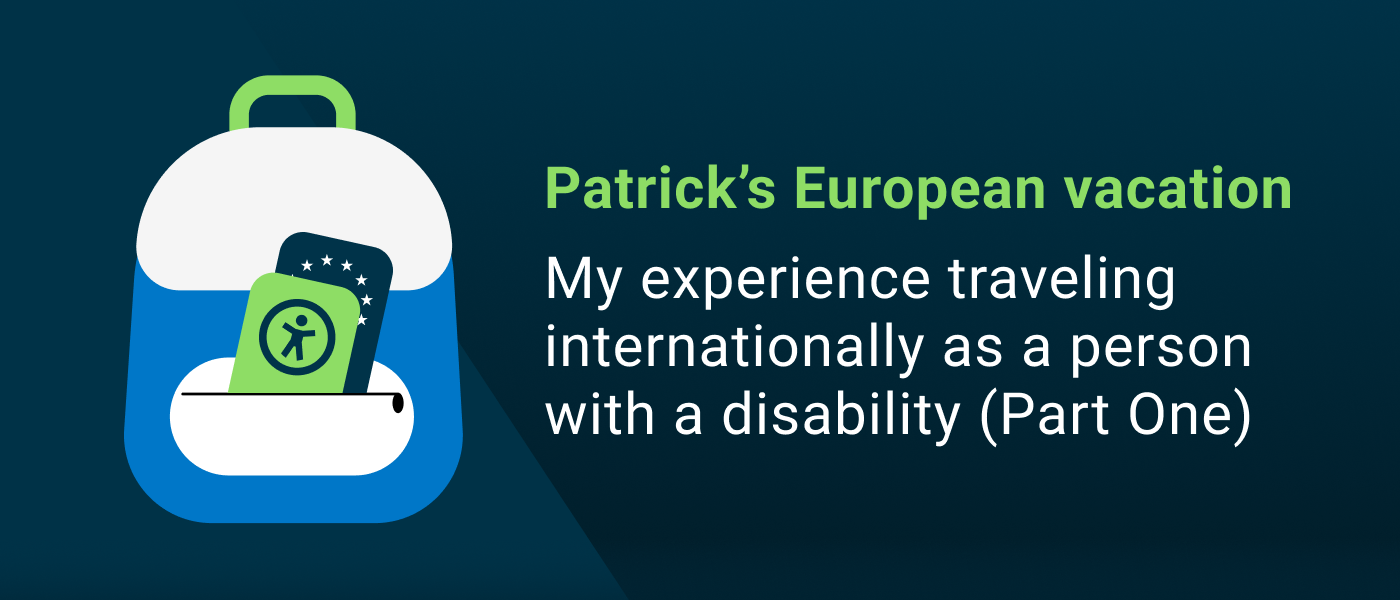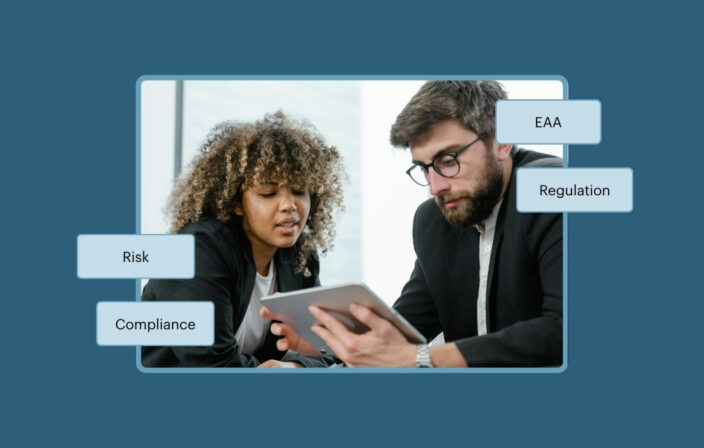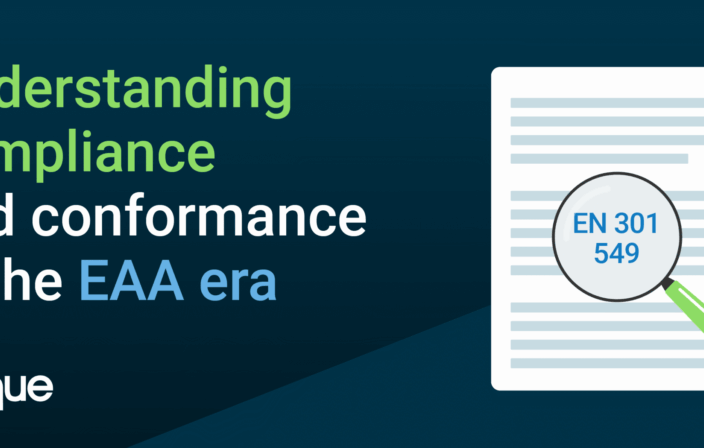International travel poses many fascinating challenges for travelers and the companies transporting them. When you take off in one country and land in another, the regulations, policies, and procedures literally change mid-flight.
For travelers with disabilities, these unusual circumstances have a real-world impact, as accessibility regulations also change from country to country.
If you haven’t read one of my posts before, I am blind, and in this three-part article, I describe my recent round-trip flight from my home airport in San Antonio, Texas, to Frankfurt, Germany, and back, with a particular focus on how differing levels of accessibility affected my experience.
I hope that travelers of all abilities will enjoy this, but I think it should be particularly relevant for travelers with a disability, as well as everyone from designers, developers, and executives in the airline industry to the government agencies that regulate the transportation industry and the operators of large US and European airports.
So, here’s my story!
Part One
I’ll begin by saying that I travel a fair bit for my job at Deque, attending conferences and visiting with clients. This time, however, the trip was a personal one, as I was going to visit family in Germany.
Purchasing tickets
Excited to try out a new direct flight between San Antonio and Frankfurt, I booked my tickets early and got a great deal on a premium economy seat for the trip over and a business class seat for the journey back. I was happy, because this would give me the ability to evaluate both experiences for accessibility.
Locating the flight and purchasing the tickets was as straightforward as can be expected, given the reality of having to get comfortable with a new air carrier website. There were small problems along the way, but no major blockers in my pursuit of buying tickets.
I should note that seat selection presented the usual confusing experience of trying to work through all the data required to display the options. This is a problem with almost all air carriers. Here are some recommendations for how to improve this:
- Create a filtering system that allows users to hide all taken seats.
- Provide filters that show all available window seats and aisle seats, creating an easy-to-understand quick list of options to review and choose from.
- Present all options in a table that allows users to quickly move around the seating options. This would make navigation and understanding of seat relationships much more intuitive.
Documenting my disability
Documenting my disability is always a part of the travel experience. In this case, it was a good one. I am very used to documenting my special needs for an escort on an airline’s website, and this process normally goes smoothly at the time of an online booking. To set up assistance at my destination required a call to the carrier. When I called, I was helped to document my blindness, and I was assisted in making my final seat assignments (since the seat selector had given me some problems). With everything taken care of, all that was left was to wait for my travel date to arrive!
Getting to the airport
My flight was due to depart at 8:30 pm, which was a treat for me. I could work almost the entire day, and still get to the airport during daylight. That meant no worrying about finding an Uber driver!
I am a huge fan of the curbside check-in at my local airport. Most of the time, my Uber driver can get me very close (20-50 feet) to curbside staff, and once I can make a human connection, I can communicate my needs and get the ball rolling for the accommodations I need to get me to the gate. For this trip, however, curbside check-in was not an option, as the airline I selected was a German airline with a new and exceedingly small footprint in San Antonio, which meant that airport staff possessed only general knowledge, and there was minimal signage for the ticket counter. One of my biggest friction points with traveling is making that first contact with either airline ticket staff or, ideally, airport staff assigned to assist people with disabilities.
Entering the airport
For this particular flight, a kiosk was not available. This didn’t bother me, as I normally avoid kiosks even if they are accessible, since, to my knowledge, a kiosk cannot be used to summon airport staff to assist me in navigating the airport. I completely agree that kiosks should be made accessible for those who have other disabilities than mine, but until they can fix the problem of a totally blind person easily finding the unit (usually located out in the middle of a very large room with lots of moving objects), I am probably not going to use it.
Finding the right ticket counter
Given that I only have two hands, navigating with a white cane and two roller bags (one full-size to be checked, one smaller for on-board) is quite an experience. But I figured it out and was able to make it indoors, where I found myself among a lot of people all moving in different directions. I stood there, hoping to be noticed by airport staff or a good Samaritan.
After about ten minutes of waiting for someone to volunteer to assist me, I decided to rely on technology to help me locate the right counter. For the record, I love apps that can connect a low or no-vision person with a live attendant to assist me in situations like this. So that’s what I did. I started off by panning around for the virtual assistant to get the lay of the land over a live video stream, and then they started giving me directions, and we were off.
Anytime I’m being guided virtually, it almost always happens that a good Samaritan will come up and ask if I need help. This means I’ll have a virtual assistant and an in-person version, both wanting to take me in different directions! The situation normally ends with me thanking the virtual assistant and letting them know that someone has come to help me, which is what happened on this trip. It was a good thing they did, because the counter for the airline was wedged in between two major carriers, and the sign, while prominent, was not easy to find without some hunting around.
Getting to the gate
After getting hard-copy boarding passes printed and checking my luggage, I was asked to wait for an escort to come and assist me. In less than ten minutes, airport staff arrived to help me through to the gate.
This moment can be a tricky one, as it often involves the question: “Would you like to be seated in a wheelchair?” I always decline, but that decision isn’t always respected. Fortunately, this time, it was. They offered their elbow, and we were on our way to TSA.
To be clear, I greatly appreciate the efforts of airport staff to get me successfully from point A to point B. However, my experiences do vary because the level of staff training and understanding of disabilities at each airport varies. Many assistants are either not trained on how best to assist someone who is blind, or they are uncomfortable guiding, which is why they try to insist that I sit in a wheelchair. I normally stand my ground and have even had to be insistent enough that management gets involved, at which point a new assistant willing to provide sighted guide service is located.
It’s important to know that individuals dedicated to assisting people with disabilities are not actually airport staff. They are contracted by the airlines. If you have an issue with training or service provided by escorts assisting people with disabilities, that’s the responsibility of the airlines and not the airport—at least, that’s the case in the US market.
In this case, everything went smoothly, and with my luggage checked and my airport assistant at my side to guide me, I headed off to the gate.
Getting through security
Post-Covid, my experiences with TSA have been fairly good—especially since most major airports have newer equipment that allows you to leave laptops in your carry-on.
One thing I have learned and now insist upon is that it’s important to pull out my refreshable Braille display from my bag and place it in the bin where the TSA agents can pick it up and hold it. When they scan a bag with a Braille display in it (which is technically a portable computer), they will often raise a red flag and stop everything to figure out what that foreign object is. I have been delayed as much as 30 minutes in the process of trying to offer an explanation.
I didn’t take it on this particular trip, but I wanted to mention this issue because people with disabilities often fly with gear that is essential for our independence but which is unfamiliar to most TSA agents. Education on common “disability tech” feels warranted.
Arriving at the gate
Continuing on, my assistant and I were at the gate in just minutes, and the age-old problem of finding the ideal seat arose. When you are blind, and your connection to the airline is the gate agent, you want to be as close to them as possible. This is often not an easy task. Everyone seems to want to sit as close as possible to the door, and telling an airport assistant that I need to be close to the agent doesn’t always help. Often, the gate agent isn’t there yet, so checking in with them directly isn’t even possible. So, I have to do my best to get the assistant to clearly explain to me the orientation of my chair to the gate agent and the door to the jetway. I usually get pretty mixed results.
I finally got seated, and at that point, I was about two hours early. I settled in for a long wait. I could actually hear some German conversation happening near me, which helped reassure me that I was, indeed, in the right place for my flight!
Boarding
When it was time to board, things got a little tense. I admit that I am a creature of habit, and I am accustomed to being pre-boarded. But no pre-board was called. So, I decided to take matters into my own hands. I got up and started trying to head in the direction of the jetway. Unfortunately, things didn’t work out the way Patrick wanted them to. Suffice it to say, ropes are my worst enemy! I got pretty turned around. Luckily, a good Samaritan once again came to my rescue and gave me a hand getting to the beginning of the line, where I was able to ask about pre-boarding. I was quickly given an apology and told that the escort had not yet arrived. Lucky for all involved, they were there within a matter of minutes, and they took over the management of getting Patrick where he needed to be. I was successfully taken down the jetway for a short wait and then turned over to onboard airline staff, who showed me to my seat.
Conclusion
That’s the end of Part One!
I hope I’ve begun to give you a meaningful sense of what international air travel can be like for someone with a disability, and how much of a difference it can make to have support available. Accessibility requires a lot of forethought and planning, but once it’s embedded, it’s literally life-changing. I am blind, but thanks to several factors—ranging from accessible websites and virtual assistants to well-trained airport staff—I was able to safely make it to my gate on time, ready for my international flight to Germany.
Please stay tuned for Part Two, where I’ll talk about the flight, the varying degrees of accessibility I experienced with everything from in-flight entertainment to reclinable seats, and how well my German escort was able to help me navigate deplaning and immigration.
Until then, travel safely. And if you see someone in need of assistance, consider being a good Samaritan and offering to help. We continue to work toward a world that is fully accessible to all, regardless of their abilities, but a little human connection still goes a long way.
~
Want to learn more about digital accessibility? Visit deque.com today!




